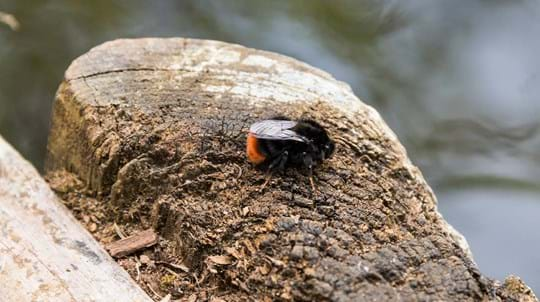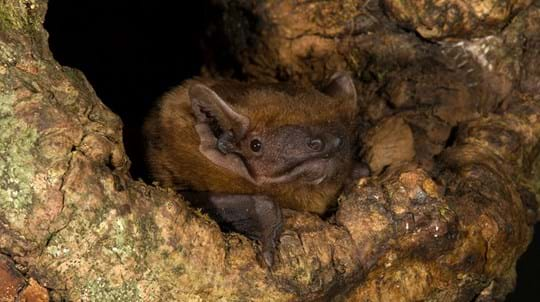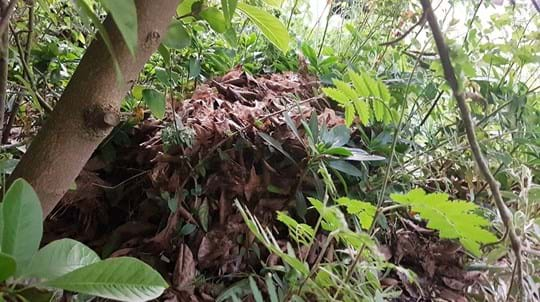Identify woodland birds on the go
Keep our pocket-sized identification guide to hand on your next walk.
Buy yours now
Digital content editor
Winter can be tough for people and wildlife, but it’s not all bleak – the season has a beauty all of its own. While some animals have flown south or tucked themselves away for the winter, you needn’t do the same.
It's important for our mental health to stay connected with the natural world, even during the darkest, coldest months. So, grab your binoculars, step out into that crisp winter air and take a wander through a woodland to see what you can find. Here’s our guide to the best British wildlife you can see in winter, plus where and when to find it.
Waxwings are irruptive migrants, meaning their movements are highly variable. Years where they do arrive in the UK are known as 'waxwing winters'.
In winter, many small birds rove the woodland in large mixed-species foraging parties, while garden visitors are as busy as ever. There are new arrivals too – visitors from across the water, here to make the most of the bountiful feeding opportunities brought about by the changing seasons.
Redwings and fieldfares feast on hedgerow berries, while waterbirds such as brent geese and redshanks flock to lakes and estuaries. If berries are particularly scarce in mainland Europe, parts of the UK sometimes even see the arrival of the fabulous waxwing.
As dusk approaches, look to the skies to glimpse one of Britain’s most impressive wildlife spectacles. Starlings, in their spotty plumage, gather in mind-boggling numbers in autumn and winter before they drop into their night-time roosts.
Known as a murmuration, this bird bonanza can sometimes feature thousands of individual starlings, flying in perfect synchrony. Gathering on this scale provides the birds safety in numbers, confusing potential predators. It also keeps them warmer in their roosts through the cold weather, and fosters socialisation.
Keep our pocket-sized identification guide to hand on your next walk.
Buy yours nowStealthy and serene, the owl is symbolic of the still, dark night. Early winter twilight means their waking hours increasingly overlap with ours at this time of year, making it more likely that you’ll spot the ghostly shape of an owl while out and about.
Barn owls can often be seen hunting along country roads or the field margins of grassland and farmland. These elegant birds of prey can be seen at many of our sites, including Brynau Farm in Wales and Heartwood Forest, near London. If food is scarce, you might even see them during daylight. When darkness falls, listen carefully for the ‘twit-twoo’ of another British owl species – the tawny owl – usually heard near broadleaved woodland.
Winter can be a tough time for our squirrels. But if you’ve seen these cheeky critters scampering about in summer or autumn, you might have noticed them caching their nuts in shallow holes in the ground.
This habit of hoarding food comes in handy during the cold months, as red squirrels do not hibernate in winter – instead remaining active throughout the year. Their recognisable russet coats develop a tinge of grey in response to winter's arrival, while rather fetching tufts of fur appear above their ears. Now mostly restricted to pockets of Scotland, northern England and Wales, you can see red squirrels in woodlands such as Ledmore & Migdale, Parc Mawr or Glen Finglas.
While we often associate hares with mad March boxing – a pastime enjoyed by the brown hare – there is another species of hare in the UK, one which gets all dressed up for winter.
As speedy as its lowland cousin but far hardier, the mountain hare can be found on heathland in the Scottish Highlands and the Peak District of northern England. These rugged rodents are grey-brown for most of the year but turn white in winter to blend in with the snow – an iconic winter wildlife sight. Mountain hares can be found in the wild expanse of our Gleann Shìldeag Estate in Scotland.
January is fox mating season – listen for the vixens calling to males at night. This chilling sound carries further in the crisp air of winter and can easily be mistaken for something more sinister.
Foxes tend to be most active at dawn and dusk. While they can be found in many of our woods, your best chance to see them is often in towns and cities. Here, urban foxes have grown accustomed to people and are far less wary, offering the chance to get closer views.
Hazel catkins, like little cigars, are exposed by the leaf fall. Watch them from January as they transform into yellow lamb’s-tails. The tiny female hazel flowers are a speck of hot pink against the grey palette of winter, but you’ll have to look closely to find them.
You might witness a magical courtship dance performed on the wing by clouds of winter gnats who gather in woodland glades. Each male ascends, then floats back down to the group before repeating his display. Their clear wings catch the low winter sunshine as they dance.
This is known as lekking behaviour – a competitive display aimed at attracting a female. Don’t be afraid to take a closer look, they don’t bite! Found widely in the UK, winter gnats are one of the few insects active in winter.
Binoculars can help you get a closer look but aren’t essential for connecting with nature – don’t worry if you don’t have any.
You will enjoy your time in nature a lot more, and be able to stay out longer, if you are comfortable – so wrap up warm with fluffy socks and sturdy water-tight boots. Hats, gloves and scarves and a flask of hot chocolate are a must for standing around waiting for the starling murmuration to start. Or take a full winter picnic!
Swatch books are a good way to ID species you spot on your walks and are less tricky than a traditional ID book to flick through while wearing gloves. Or look at our online ID guides before you go to help you tell a bullfinch from a brambling, or a tawny owl call from that of a barn owl.
Timing is everything - get out soon after sunrise if you can. The frosty mornings are beautiful but can soon melt away, and birds are most active early in the morning, feeding to replenish the energy they lost keeping warm overnight. Or go in late afternoon to witness amazing sunsets and birds heading to roost.
Explore different habitats. The more you can visit, the larger the variety of species you’ll spot. See what you can spy in your own garden, the local city park, woodlands, fields, hedgerows, lakes, riverbanks and reedbeds.

Primordial landscapes, tangled branches, breathtaking wildlife and miles of woodland trails. From the countryside to cities, we care for thousands of woods throughout the UK, all free to visit.
Find a wood near youKeep our pocket-sized identification guide to hand on your next walk.
Buy yours now
Blog
Charlotte Varela • 18 Nov 2022

Blog
Joe Bates • 03 Dec 2018

Blog
Charlie Mellor • 18 Sep 2020

Blog
Charlotte Varela • 21 Jan 2025